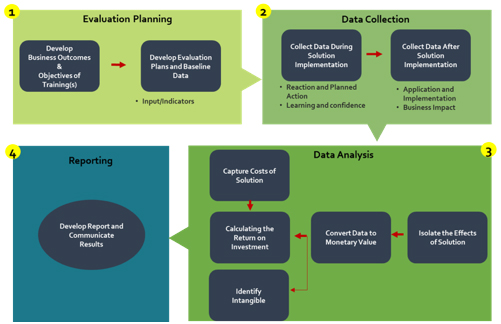Looking for ways to assess the impact of your organisation’s ROI of training? Look no more! Good training programs cost money and even the cheap ones still cost your organisation some money.
As an HR professional looking for a way to justify this expense is a concern for you. However, you are almost certain that adequate training implemented on the job has a way of improving the bottom line so scraping training is not an option.
Research has shown that developing your people and improving their skills can:
- improve employee motivation
- improve customer satisfaction
- increase their productivity and quality of work
- increase overall profits
- give you a competitive advantage
- reduce staff turnover and absenteeism
- help you adapt to change and prepare for growth and;
- enable you to reach new markets overseas
The Problem
The problem of evaluating the effectiveness of your training when the outcomes involve soft skills such as teamwork, creativity and strategic thinking is mind boggling. It can be difficult to assign a naira value to such skills, or to show a relationship between the learning initiative and the acquisition of the targeted skills.
The inability to measure the ROI of training or the impact of these trainings may be because the approach most organizations and HR practitioners take for learning and development is fundamentally flawed – they make a list of skills required during the period under review, identify facilitators, get adequate venues and select a range of people to attend. At the end of the training, they distribute “smiley sheets” with questions relating to venue and facilitator’s style (with HR executives playing roles of Admin staff rather than strategic HR) and file them away as feedback on the training.
In the past, Executives may see feedback and anecdotes from participants as sufficient to assess the value of an in-house leadership development program, but with today’s challenging economy however, it is no longer business as usual. Learning & Development budgets are receiving more scrutiny than ever and many HR and talent management professionals are feeling the pressure to look for more solid evidence to justify the investment in their programs.
So then…
Is there really a way to effectively measure the return on investments made on trainings? Can we ensure training success is expressed directly as a business contribution?
The Solution
Best practice organizations try to ensure that they get the most of their training programs by ensuring the programs:
- are linked to business’s goals and performance
- are part of a business-wide strategy
- have tangible and obtainable objectives for the employees
- focus on helping employees carry out existing tasks more efficiently or to a higher standard
- have varying learning styles embedded including classroom, self-learning, on-the-job, and coaching
- can train individuals to take on a different role – e.g. with increased responsibilities
- set out who is responsible for planning, implementing and evaluating the training
Case Study
In 2008, J.C. Penney a UK retailer, found itself among the bottom of all UK retailers in customer satisfaction with a rating of 43 percent. The organization realized the need to engage and educate its 155,000 associates in 1,100 stores, logistics centers and headquarters to raise its customer satisfaction rating. This meant they had identified a tangible and obtainable objective: improved customer satisfaction ratings.
The retailer then went ahead to train its associates through a multi-faceted approach (varying learning styles) that had distinct messages for each targeted population (store leaders, store associates and home office associates).
Though the retailer identified that key to the initiative’s success was the support from all levels of employees, they gave deliberate focus to store managers so that they could “champion” the message. All store associates then participated in learning sessions—delivered by store managers and the training supervisor team–within three months of the store manager’s learning program.
The result? Customer satisfaction ratings increased from 48 to 63 percent by the end of 2010, ranking J.C. Penney as top in customer service.1
The Framework
So what are the steps your company can take to ensure that the L&D interventions are translated into monetary value and how will it impact the bottom-line? Below is our tried and tested framework to help clients measure the Return on Investment from L&D interventions:
Fortunately, once you understand the basics of training and development ROI methodology, the natural chain of impact really begins to make sense.
Our framework provides a comprehensive insight into how to build and communicate a compelling case for the learning and development function. It will enable you demonstrate the tangible and intangible returns of L&D investment, and present the information in a format that is acceptable to key stakeholders.
Recommended Post: Top 5 Ways to Improve Executive Team’s effectiveness


